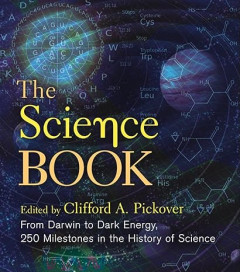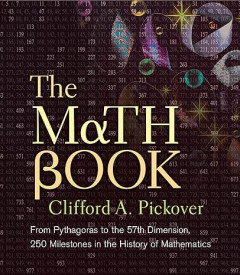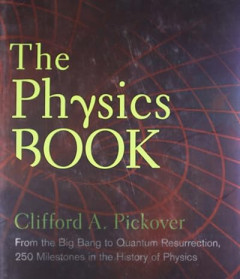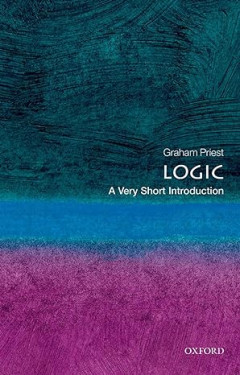Ditapis dengan

E-book The Science Book: From Darwin to Dark Energy, 250 Milestones in the Hi…
From astronomy to psychology, this beautifully illustrated chronology presents the most important and groundbreaking milestones in science. Award-winning author Cliff Pickover (The Math Book, The Physics Book, and The Medical Book) gathers into one fully illustrated volume the most important thinkers and ideas in the history of science. This unique omnibus edition includes 250 thoughtfu…
- Edisi
- -
- ISBN/ISSN
- 9781454933007
- Deskripsi Fisik
- 779 halaman, ilus.
- Judul Seri
- -
- No. Panggil
- 500.0 PIC t
E-book The Medical Book: From Witch Doctors to Robot Surgeons, 250 Milestones…
Following his hugely successful The Math Book and The Physics Book, Clifford Pickover now chronicles the advancement of medicine in 250 entertaining, illustrated landmark events. Touching on such diverse subspecialties as genetics, pharmacology, neurology, sexology, and immunology, Pickover intersperses “obvious” historical milestones--the Hippocratic Oath, general anesthesia, the Human Gen…
- Edisi
- -
- ISBN/ISSN
- 9781402792335
- Deskripsi Fisik
- 567 halaman
- Judul Seri
- -
- No. Panggil
- 610.9 PIC t

E-book The Math Book: From Pythagoras to the 57th Dimension, 250 Milestones i…
Beginning millions of years ago with ancient “ant odometers” and moving through time to our modern-day quest for new dimensions, The Math Book covers 250 milestones in mathematical history. Among the numerous delights readers will learn about as they dip into this inviting anthology: cicada-generated prime numbers, magic squares from centuries ago, the discovery of pi and calculus, and the …
- Edisi
- -
- ISBN/ISSN
- 9781402757969
- Deskripsi Fisik
- 534 halaman
- Judul Seri
- -
- No. Panggil
- 510 PIC t

E-book The Physics Book: From the Big Bang to Quantum Resurrection, 250 Miles…
Following the hugely successful The Science Book and The Math Book comes a richly illustrated chronology of physics, containing 250 short, entertaining, and thought-provoking entries. In addition to exploring such engaging topics as dark energy, parallel universes, the Doppler effect, the God particle, and Maxwells demon, the books timeline extends back billions of years to the hypothetical Big…
- Edisi
- -
- ISBN/ISSN
- 9781402790997
- Deskripsi Fisik
- 606 halaman, ilus.
- Judul Seri
- -
- No. Panggil
- 530 PIC t
E-book What Photographs Do: The Making and Remaking of Museum Cultures
What are photographs ‘doing’ in museums? Why are some photographs valued and others not? Why are some photographic practices visible and not others? What value systems and hierarchies do they reflect? What Photographs Do explores how museums are defined through their photographic practices. It focuses not on formal collections of photographs as accessioned objects, be they ‘fine art’ or…
- Edisi
- -
- ISBN/ISSN
- 9781800082984
- Deskripsi Fisik
- 357 hlm
- Judul Seri
- -
- No. Panggil
- 069 EDW w

E-book Logic: A Very Short Introduction
Logic is often perceived as having little to do with the rest of philosophy, and even less to do with real life. In this lively and accessible introduction, Graham Priest shows how wrong this conception is. He explores the philosophical roots of the subject, explaining how modern formal logic deals with issues ranging from the existence of God and the reality of time to paradoxes of probability…
- Edisi
- -
- ISBN/ISSN
- 9780195682625
- Deskripsi Fisik
- 146 halaman.
- Judul Seri
- -
- No. Panggil
- 160.0 PRI l
E-book Human Rights in Child Protection : Implications for Professional Pract…
Professional practice is a defining trait of modernity, and democratic and constitutional nation-states depend on professional practitioners and their efforts to solve problems and coordinate activity in order to distribute state services as accurately as possible, thus dealing with the particular problem at hand of implementing human rights. Throughout modern history, legis-lators in different…
- Edisi
- -
- ISBN/ISSN
- 9783319948003
- Deskripsi Fisik
- 269 hlm
- Judul Seri
- -
- No. Panggil
- 364 CHR h
E-book The Power and the Glory
Mr Tench went out to look for his ether cylinder, into the blazing Mexican sun and the bleaching dust. A few vultures looked down from the roof with shabby indifference: he wasn’t carrion yet. A faint feeling of rebellion stirred in Mr Tench’s heart, and he wrenched up a piece of the road with splintering finger-nails and tossed it feebly towards them. One rose and flapped across the town: …
- Edisi
- -
- ISBN/ISSN
- 9789994003891
- Deskripsi Fisik
- 208 hlm
- Judul Seri
- -
- No. Panggil
- 823 GRE t
E-book Destination London : The Expansion of the Visitor Economy
No city in the world is better covered by literature – fictional and non-fictional – than London. From Pepys, via Dickens, to Ackroyd, London has benefited from a series of talented historians, novelists and commentators who have provided detailed accounts of the city’s condition. In the past few years a new tranche of books has been published on the contemporary character of the…
- Edisi
- -
- ISBN/ISSN
- 9781912656271
- Deskripsi Fisik
- 267 hlm
- Judul Seri
- -
- No. Panggil
- 721.421 SMI d
E-book Ultimate Visual Dictionary
This ultimate dictionary explains, defines and depicts more than 33,000 terms from the parts of a volcano to the components of an engine and offers detailed explanations and annotations of each.
- Edisi
- -
- ISBN/ISSN
- 9780756686833
- Deskripsi Fisik
- 674 halaman, ilus.
- Judul Seri
- -
- No. Panggil
- 030 GRA u
 Karya Umum
Karya Umum  Filsafat
Filsafat  Agama
Agama  Ilmu-ilmu Sosial
Ilmu-ilmu Sosial  Bahasa
Bahasa  Ilmu-ilmu Murni
Ilmu-ilmu Murni  Ilmu-ilmu Terapan
Ilmu-ilmu Terapan  Kesenian, Hiburan, dan Olahraga
Kesenian, Hiburan, dan Olahraga  Kesusastraan
Kesusastraan  Geografi dan Sejarah
Geografi dan Sejarah